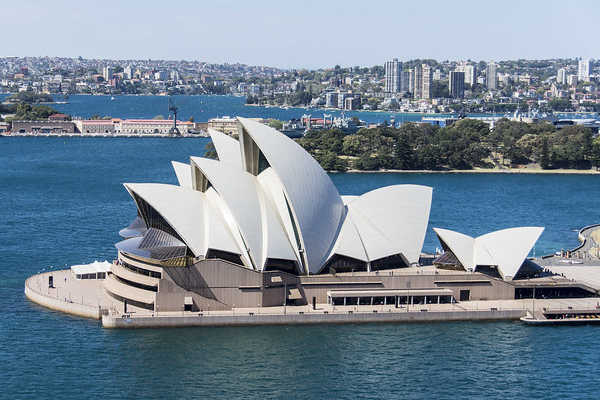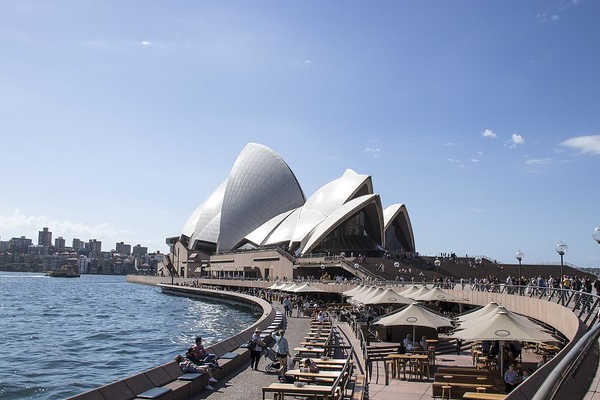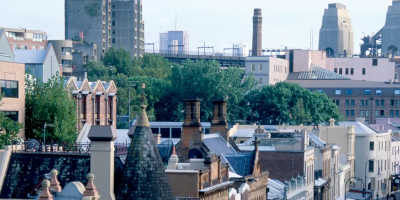Sydney Opera House, New South Wales
Sydney, New South Wales 2000
The Sydney Opera House is one of Australia’s most iconic buildings. The impressive sails of the building characterise Sydney City and provide a fascinating place to explore the culture and modern history of the country.
Designed by Jorn Utzon, a Danish architect, the Sydney Opera House was opened back in 1973, almost 20 years after Utzon was chosen as the winner of an international design competition.
Getting to Know The Sydney Opera House
Though the name suggest that the opera house is just one single venue, it in fact comprises several performance halls and venues that are some of the busiest and most-used in the entire world. Each year, more than 1,500 performance take place under the roof of the Sydney Opera House, and more than 1.2 million people attend them.
Every year, the selection of shows is mixed up, with performances by the likes of Opera Australia, the Australian Ballet, Sydney Theatre Company, and the Sydney Symphony Orchestra.
As well as attendees to the performances, more than eight million people visit the site of the Sydney Opera House every year, with around 350,000 people taking a guided tour of the interior.
Obviously, the best way to experience the Opera House is to book a seat at one of the performances, but if you want to learn more about the architecture and the exterior of the building rather than what goes on on the stages, you can take a guided tour. They range in levels, starting from a simple one-hour tour to an “access all areas” backstage pass which includes breakfast in the famous Green Room.
Fun Facts About the Sydney Opera House
-
There was a Competition on who would Design it
It was designed by Jorn Utzon, who won a design competition in the late 1950s. There were over 233 different designs submitted, but Utzon’s unique sail like roof won the hearts of the judges.
-
The Queen was First to open the Doors
The doors were opened by Queen Elizabeth II on the 20th October 1973.
-
Opera was its First Love
The first official performance at the Sydney Opera House was the Australia Opera’s production of War and Peace. However, this isn’t in fact the very first act, with Paul Robeson being the first person to perform at Sydney Opera House. With Robeson climbing the scaffolding in 1960 during construction time to sing the Ol’ Man River to the construction workers as they ate lunch.
-
It was Very Expensive
The estimated cost of the Sydney Opera House was around 7 million dollars; however, it actually came to $102,000,000 AUS to build. A large majority of the cost ended up being paid for by the State Lottery.
-
Its Calendar is Always Busy
Every year, there are more than 3000 events that take place at the Sydney Opera House. With more than 10.9 million visitors to the house very year.
-
The House has a lot of Space Inside
It might not look so big in the photos, but the Sydney Opera House is actually quite expansive. With over 1,000 different rooms inside, each with its own purpose.
-
The Roof is Unique
There are over 1 million roof tiles on the Sydney Opera House, stretching out to 1.62 hectares of space. The tiles all range in shapes and sizes, with some weighing up to 15, 000 kilograms. Each tile was made in Sweden, with concrete beams changing shape as they rise from a T shape to a Y to finally a U. These act as replacements to columns, supporting the weight of the structure as the sails sit on the heavy podium. Due to this, it is known as the biggest column free chamber in the entire world. As well as the highest roof shell, measuring up to 67 metres, the equivalent to a 22-storey building.
-
Changed Thousands of Light Bulbs Every Year
As you can imagine, the sheer size of the Sydney Opera House means there are literally hundreds and hundreds of rooms set inside. That also means there are thousands and thousands of light bulbs which, inevitably, need changing every now and again. On average, a whopping 15,500 light bulbs are changed ever year at the Opera House – not an easy task.
-
Its Air-Con uses Sea Water
Sydney Opera House doesn’t have the usual air con installed but uses its location to its advantage. Taking the seawater directly from the harbour to circulate it into the cooling system. The cold water runs through the 35 kilometres of pipers, which powers both the cooling and heating in the building. The system circulates cold water from the harbour through 35 kilometres of pipes to power both the heating and air conditioning in the building.
-
It took a While to Finish
Before commencing construction, it was estimated that the Opera House would take about four years to complete. In the end however, it actually stretched out to 14 long years. During the development, many of the world’s best construction companies were involved in construction, including the well-known Arups Structural Engineering, Hornibrook and Rider Hunt.
-
There was once a Net in the Opera House
Back in the back (the 1980s to be exact) there was a large net covering the orchestra pit. The net was installed above the orchestra following an unfortunate occurrence during the opera of Boris Godunov. This particular opera containing live chickens in the performance, and during the event one of the birds walked off the stage, landing directly on top of a cellist.
-
It is a World Heritage Listed Site
The iconic Sydney Opera House was added to UNESCO’s World Heritage List in 2007 and remains a World Heritage site to this day.
-
The Opera House’s Temperature is Important
The temperature of the concert Hall must be exactly 22.5 degrees in temperature when the Sydney Symphony Orchestra performs. This ensures the instruments stay in tune, with the humidity and temperatures very easily affecting the instruments.
Visiting the Sydney Opera House is an important part of any trip to Australia. This iconic landmark is not only a great place to experience some of the country’s best-loved performances, but it is also a great place to explore the architectural history of the city and the cultural scene that imbues the region surrounding the building.
You can opt to simply marvel at the building from the outside, or you can head on in to watch a show or take a guided tour around some of the 1,000 rooms inside.












